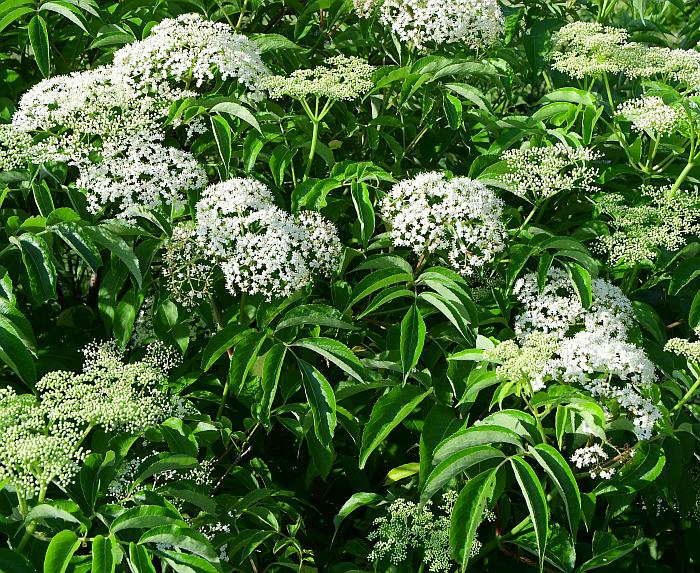Sambucus canadensis L.
Common Elderberry

Native
CC = 2
CW = 0
MOC = 64
© SRTurner
Sambucus canadensis L.Common Elderberry | |
 |
Native CC = 2 CW = 0 MOC = 64 |
© SRTurner |
|
Family - Caprifoliaceae Habit - Shrubs or small trees 1-8 m tall, usually with stout, spreading rootstocks and suckering from the roots. Stems - Ascending to erect, branching, multiple from base. Bark yellowish brown, tight, lacking ridges but appearing roughened or warty. Twigs 3-5 mm thick, glabrous, the pith white.
Leaves - Opposite, pinnately compound. Petioles 3-7 cm long, glabrous except in the ventral groove, where densely pubescent with minute, scurfy hairs. Petiolules to 5 mm. Leaflets usually 7-9 per leaf, 5-12 cm long, 2-6 cm wide, lanceolate to narrowly oblong or elliptic, the upper surface glabrous, the undersurface usually minutely hairy along the veins, rarely also hairy on the tissue between the veins, the margins crenate-serrate.
Inflorescence - Terminal compound cymes, more or less flat-topped, sometimes domed, lacking an elongate main axis, instead with usually 5 primary branches (these repeatedly branched).
Flowers - Corolla white, 5-lobed, glabrous, 3-5 broad. Lobes 2.2 mm long, 2 mm broad, rounded to emarginate at apex. Stamens 5, adnate at base of corolla tube, alternating with corolla lobes, erect to spreading. Filaments white, glabrous, 2.4 mm long. Anthers yellow, 0.5mm long. Stigma 5-lobed, capitate. Ovary inferior, 4-locular.
Fruits - Drupes 4-6 mm in diameter, globose, purplish black (rarely red), edible in moderation, and palatable, with a pleasant flavor. Seedlike nutlets (also called pyrenes or stones) 3-5, 2.5-3.0 mm long, more or less obovate to elliptic in outline, somewhat flattened or bluntly 3-angled, the surface roughened with irregular, fine cross-wrinkles or blunt, low ridges, yellowish brown to brownish yellow.
Flowering - May - July. Habitat - Bottomland and mesic forests, streambanks, pond margins, prairies, pastures, fields, gardens, railroads, roadsides, and moist disturbed areas. Origin - Native to the U.S. Lookalikes - None close. Other info. - This species is common across most of Missouri, and occurs across the eastern half of the continental U.S. and into Canada. It generally favors moist areas. It is easily recognized by its pinnately compound leaves on stout, fleshy stems and large inflorescences of small white flowers. A thriving plant will produce numerous inflorescences, and these can sometimes reach nearly a foot in diameter. Photographs taken at Busch Wildlife Area, St. Charles County, MO, 6-12-2009, Glassberg Conservation Area, Jefferson County, MO, 8-5-2020, Klondike County Park, St. Charles County, MO, 6-10-2022, and near Labadie, Franklin County, MO, 6-13-2022 (SRTurner). |